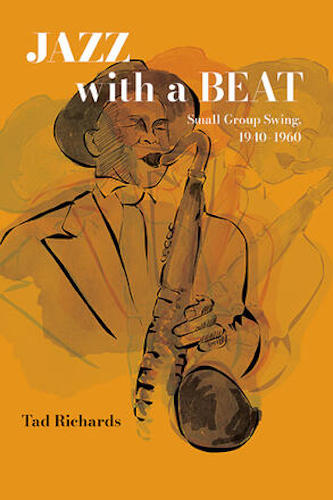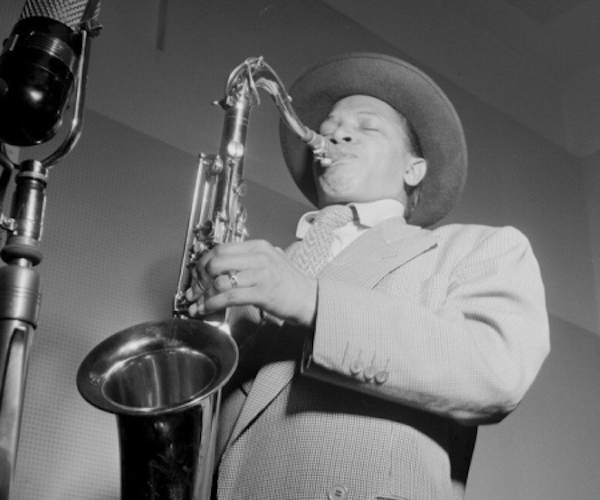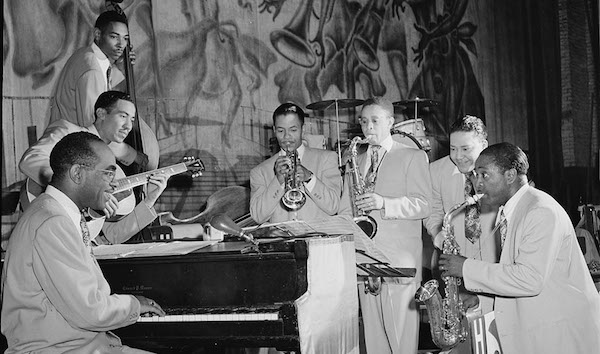Book Review: “Jazz With a Beat: Small Group Swing, 1940-1960” — Told With an Edge
By Steve Provizer
Shouting and honking saxes made visceral appeals to the emotions and the body. For jazz critics, this kind of theatricality degraded what should have been “Art.”
Jazz with a Beat: Small Group Swing, 1940-1960 by Tad Richards. SUNY Press, 188 pages, (paperback) $29.95.

Jazz is a mongrel, not a purebred. It was self-created as a merger of blues, brass band, circus, ragtime, vaudeville, minstrel, Caribbean music, European harmony, and African rhythm. Of course, some of these genres were hybrids themselves. Still, even in the face of this, people have always wanted to pinpoint “real” jazz. Realness is in the eye of the beholder, but the emotional attachments we make to the music are so strong that the battle has never stopped and it never will.
Many know about the conflict in the early ’40s between the Boppers and the “Moldy figs,” those who favored the sounds of early New Orleans. Louis Armstrong famously called Bop “Chinese music” (author Tad Richards mistakenly gives this quote to Cab Calloway). But there was another vector of jazz emerging as well. Illinois Jacquet’s solo on “Flying Home” with the Lionel Hampton band in 1942 exploded out of the box with as much force as Bop. You can compare its effect to Armstrong’s “West End Blues” in 1928 or Charlie Parker’s “Koko” in 1945.
Looking at how those three solos were received brings us to the central beef at the heart of Jazz With a Beat. Musicians and critics agree on the musical importance of “West End Blues” and “Koko.” They admire the technique and creativity, and acknowledge the influence these solos had on the shape of jazz. But that kind of appreciation is not so easy in the case of “Flyin’ Home.” Many musicians at the time admired Jacquet’s energy, but critics generally downgraded the performance as showboating, charging that it lacked substance and did not contribute to the “progress” of jazz.
For many years, jazz historiography was largely (although not exclusively) the province of white critics. And to a greater or lesser degree those judgments about the “value” or “contribution” that any particular musician made to jazz diverged from the listening choices preferred by Black audiences. The historians go into detail about Ellington and Basie, maybe Lunceford and Webb in the ’30s. But what about Andy Kirk, Buddy Johnson, Erskine Hawkins, or Lucky Millinder? In the ’40s-’50s, the music of Jacquet and the honkers, Louis Jordan along with many others, was the popular Black music of the era.
But in order to be considered hip in the ’40s and ’50s, jazz journalists covered bop, maybe Tristano, Cool, West Coast, Hard Bop, Third Stream (maybe), and then the arrival of Ornette Coleman. The fact that small group swing/jump was almost completely a Black phenomenon, and that it was happening in L.A. and not Chicago or New York, also meant that its practitioners would receive less press attention.
These bands played great music, but they also put a premium on snappy uniforms, choreography, and humor. Shouting and honking saxes made visceral appeals to the emotions and the body. For jazz critics, this kind of theatricality degraded what should have been “Art.” Meanwhile, the bands and their performances resonated with Black audiences. Other Black musicians quickly saw the attraction, noted how it would get them work, and they joined the fray.

Saxophonist Illinois Jacquet, one of the creators of small group jump. Photo: WikiCommon
Richards thoroughly explores the careers of two important early practitioners of small group jump, the aforementioned Illinois Jacquet and saxophonist/vocalist/songwriter Louis Jordan. The pair essentially created the approach in the late ’30s-early ’40s. The imminent demise of big bands made this timing that much more propitious.
Richards has a strong brief against the tide of criticism that he believes disrespected this strain of music — call it small group swing, jump music, or rhythm and blues. He argues that jazz has always been a niche music. Commercial white bands had most of the hits, and they only occasionally used jazz players. (He mistakenly says that Tram and Bix played with Glen Grey when it was Paul Whiteman). I half take his point. Most bands played some mix of dance music along with some jazz inflections and solos. Histories of swing music should acknowledge the popularity of bands like Horace Heidt, Freddy Martin, Shep Fields, Kay Kyser, and Guy Lombardo. American listeners and dancers were perhaps not as hip as we are told they were.
Jazz with a Beat shows that there was a large pool of musicians who played in many different subgenres of jazz. In particular, there was considerable fluidity among the camps of hard bop, rhythm and blues, and small group swing/jump. When Benny Golson enters into a heated saxophone battle with Red Prysock on Tiny Grimes’s “Battle of the Mass,” it is still Benny Golson. Big Jay McNeely — who was as staunch a honker and shouter as anyone — studied classical music. And he played with Hampton Hawes and Sonny Criss.
Scores of musicians who went on to wide acclaim spent time in R&B oriented bands. Earl Bostic, who many said had as much technique as Charlie Parker, fostered the careers of Keter Betts, Jaki Byard, Benny Carter, John Coltrane, Teddy Edwards, Benny Golson, Blue Mitchell, Tony Scott, Stanley and Tommy Turrentine. Wynonie Harris’s backup musicians included Connie Kay, Johnny Griffin, Joe Morris, Elmo Hope, Gene Ramey, and many others. Sonny Blount (Sun Ra) plays on Harris’s 1942 “Dig This Boogie” (Sun Ra’s first known recording). Wild Bill Davis, a key architect of the organ trio sound, arranged “April in Paris” for Basie. He was supposed to play organ but couldn’t make the gig.
As Richards shows, this was initially a West Coast phenomenon. More specifically L.A. and most specifically, Central Ave. in L.A. There was a long-standing jazz scene in L.A. — Kid Ory moved there in 1919 — and many musicians migrated to the area after playing in Southwest territorial bands. For example, Milt Larkin’s Southwest territory band launched Jacquet, Arnett Cobb, and Eddie Cleanhead Vinson, all of whom moved to L.A.

Louis Jordan (right) and his Tympany Five in New York City between 1946 and 1948. Photo: Wiki Common
There were also scenes in New Orleans, Detroit, and in New York City. The New Orleans pool of musicians included Paul Gayten, Dave Bartholomew, Fats Domino, Little Richard, Lloyd Price, James Booker, Alan Toussaint, Mac Rebennack (Dr John), and Lee Allen. Not a motley crew.
The Detroit scene was well documented by Savoy records. Paul Williams had their biggest hit, initially called “D’Natural Blues.” He renamed it after a popular dance, “The Hucklebuck,” which jazz people recognize as Charlie Parker’s “Now’s the Time,” which predated the Williams effort by a few years.
By 1949, Atlantic Records in New York knew this was a ripe musical area for exploration. In fact, that year it was Atlantic’s Jerry Wexler who coined the phrase “rhythm and blues.” For chief producer they appointed Jesse Stone, who had worked with all the major big bands; for Atlantic he had scored hits with Frank Culley, Ruth Brown, and Joe Turner. Willis “Gator Tail” Jackson was known for honking, but he also used Bird, Bud Powell, and Eddie Lockjaw Davis in his bands. Then came Ray Charles and his crew — David Fathead Newman, Cecil Payne, and Hank Crawford. Then King Curtis and Plas Johnson (the “Pink Panther” sax theme).
I think you get the picture. This was music that was meant to entertain, to excite, and to get people off their chairs. It required high levels of musicianship, creative arrangements, and an understanding of the format. It’s music that may be a little more for the body than the head, but does that make it less “real”? In some ways, it makes it more real. This book takes a slice of the story told by Bob Porter in his book Soul Jazz: Jazz in the Black Community, 1945-1975 and amplifies it. Richards has got a bit of a chip on his shoulder, but that’s fine. It’s a story that calls for some edge and he tells it that way.
Steve Provizer writes on a range of subjects, most often the arts. He is a musician and blogs about jazz here.

Mouldie Fygge!
This piece is essential reading, unwrapping an important attitude about the thrill and joy of jazz that deserves more ink. I was very happy to see Illinois Jacquet in large festival settings near the end of his career, and to witness the visceral reaction of the crowd as he unleashed his theatrical sax eruptions. There’s a great double album of Central Avenue jazz that’s a real keeper. One of my favorite jump jazz tunes is “Blow Me Down,” from a collection of Esquire Magazine 1940s-era annual jazz polls. The high-brow jazz critics picked the best of the modern crop for awards, but the players themselves chose to play a jubilant, lindy-hopping blast of a rug-cutter. Coleman Hawkins, who played every style going, is the main soloist. Solid Jackson!